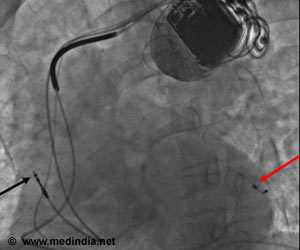EvPatients receiving an implantable cardioverter-defibrillator (ICD) for primary prevention often receive a dual-chamber ICD.

"The central decision regarding ICD therapy is whether to use a single- or dual-chamber device," according to background information in the article. More complex dual-chamber devices may offer theoretical benefits beyond single-chamber devices for patients without an indication for pacing, but may also have greater risks. In a national sample, more than two-thirds of patients receiving an ICD received a dual-chamber device. "The outcomes of dual- vs. single-chamber devices are uncertain."
Pamela N. Peterson, M.D., M.S.P.H., of the Denver Health Medical Center, and colleagues conducted a study to compare outcomes, including mortality, hospitalizations, and longer-term implant-related complications between single- and dual-chamber devices. The study included admissions in the National Cardiovascular Data Registry's (NCDR) ICD registry from 2006-2009 that could be linked to Centers for Medicare & Medicaid Services fee-for-service Medicare claims data. Patients were included if they received an ICD for primary prevention and did not have a documented indication for pacing.
Among 32,034 patients, 12,246 (38 percent) received a single-chamber device and 19,788 (62 percent) received a dual-chamber device. After analysis of the data, the researchers found that rates of complications were lower for single-chamber devices (3.51 percent vs. 4.72 percent), but device type was not significantly associated with 1-year mortality (unadjusted rate, 9.85 percent vs. 9.77 percent), 1-year all-cause hospitalization (unadjusted rate, 43.86 percent vs. 44.83 percent), or hospitalization for heart failure (unadjusted rate, 14.73 percent vs. 15.38 percent).
The authors suggest that their study advances the understanding of the risks of dual-chamber devices. "Because implanting a dual-chamber ICD is a more complex and time-consuming procedure than implanting a single-chamber device, the possibility of device-related complications such as infection and lead displacement requiring device revision is likely to increase. Indeed, we observed a greater risk of complications among patients receiving dual-chamber devices."
"Many patients receiving primary prevention ICDs receive dual-chamber devices. Dual-chamber devices do not appear to offer any clinical benefit over single-chamber devices with regard to death, all-cause readmission, or heart failure readmission in the year following implant. However, dual-chamber ICDs are associated with higher rates of complications. Therefore, among patients without clear pacing indications, the decision to implant a dual-chamber ICD for primary prevention should be considered carefully."
Advertisement









